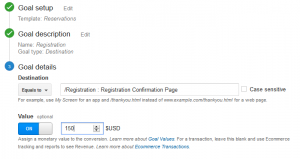Measuring the return on your website’s investment is an elusive concept for many organizations. For many, measuring consists of visitors or page views. In my travels and at various conferences, I often hear similar questions. Where do you start? What else can you measure? But how does that translate to dollars and cents? With a little set up and a bit of follow-through, it can be easy to look at your website as a revenue center and not some red line on your accountant’s books.
What’s Your Goal?
For years, mankind has been concerned with “the meaning of life.” Your website has the same concerns. Every website needs a goal. If you’re directly selling on your site, your goal is likely having a visitor complete a sale. That is a goal you should measure. Some common website goals are:
- Direct Sales
- Sales Leads
- Requests for information
- Whitepaper or other document downloads
- Advertisements served and/or clicked
Do Your Goals Have Value?
 Ultimately goals are what generates revenue. If you have an ecommerce goal, your ecommerce software should ultimately be able to dynamically insert the value of a transaction into your data layer or goal event. But what about non-transaction goals, like downloads or lead-gen forms for B2B websites?
Ultimately goals are what generates revenue. If you have an ecommerce goal, your ecommerce software should ultimately be able to dynamically insert the value of a transaction into your data layer or goal event. But what about non-transaction goals, like downloads or lead-gen forms for B2B websites?
I’ll grant you that a lead or a download are not guaranteed customers who will immediately generate revenue. But they start to build trust and establish a relationship with potential clients. how many of your sales team say to you, “if I get the initial meeting, I’ll close the deal”? Thought so.
Leads and sales have value. In your Web analytics software, you can set goals and add a value to them. The value you assign is a quantitative measurement of the revenue you directly generated through sales or hope to generate through the new lead. Granted, it’s not as easy to apply a value to a lead as it is to direct sales that have a dollar amount associated with the transaction.
Consider this:
Generally speaking, leads generated through web forms are warm leads. People have sought out your site, pursued it, entered data through your form and submitted it, entrusting your site with their personal email address. What is the long-term value of one of your customers? On average, what percentage of warm leads do you turn into long-term customers? Multiply those numbers out and that’s the average value of a website lead.
For example if:
- over the lifetime of the relationship, the average revenue for a customer is $1000
- your sales force can close 80% of their leads to long-term customers
Then the value of your lead is: $1000 x .8 or $800.
Stop thinking in terms of visits or page views. While these are very good metrics that can help set a baseline for other measurements, these are not the end-all, be-all. Some of you might also measure bounces – a visit where the visitor views one page and leaves your site immediately. Measuring bounces can be useful, but can also be misleading. Set goals within your analytics software and measure them. Goals are your best measure of ROI.
What What’s Our ROI?
By definition, Return on Investment means measuring your revenue based on the amount you invested. So it follows that your ROI would be the sum of all the revenue values of the your conversions, minus the cost of your investment. Are you tracking the cost per visitor? It’s easy using PPC or display campaigns with AdWords or DoubleClick. The interfaces include conversion pixel tracking that will report back to your analytics. However, what about email or social media campaigns? Do you track print or other traditional media? Data from all campaign spends must be accounted for within your ROI equations. Be sure you’re tagging all inbound links to your site to be sure. Yes, this is still possible with traditional media. Without it, you’re ROI calculations will never be accurate.

